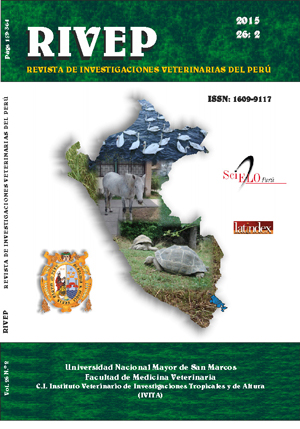Ectoparasites of pigeons Columba livia traded in a market of the district of San Martín de Porres, Lima, Peru
DOI:
https://doi.org/10.15381/rivep.v26i2.11094Keywords:
ectoparasites, Mallophaga, domestic pigeon, Columba livia, birdsAbstract
The aim of this study was to determine the prevalence, average intensity and mean abundance of ectoparasites in domestic pigeons (Columba livia). A total of 29 specimens were analyzed (17 males and 12 females). External surface of head, neck, chest, back and wings were examined, determining that 93.1% (14.9 ± 15.8 of total mean abundance) of pigeons were infected with one or more ectoparasites. All males and 83.3% of females were parasitized. Seven species of ectoparasites were identified, where five correspond to Order Mallophaga (Columbicola columbae [82.8%], Menopon gallinae [48.3%] Goniodes gigas [31%], Menacanthus stramineus [17.2%] and Lipeurus caponis [6.9%]), one to Order Diptera (Pseudolynchia canariensis [10.3%]), and one to Order Siphonapetra (Echidnophaga gallinacea [3.4%]). The largest number of mallophagans was found on the feathers of the wings and chest. Among associations, the monoparasitism was present in 28%, biparasitism in 28%, triparasitism in 34% and tetraparasitism in 3% of the pigeons. C. columbae was the most prevalent ectoparasite (82.8%). Besides, Menacanthus stramineus and Lipeurus caponis are reported for the first time as ectoparasites of Columba livia in Peru.Downloads
Downloads
Published
Issue
Section
License
Copyright (c) 2015 Asucena Naupay I., Julia Castro H., Junior Caro C., Lucas Sevilla D., Joe Hermosilla J., Katherine Larraín L., Carlos Quispe S., Oscar Panana R.

This work is licensed under a Creative Commons Attribution-NonCommercial-ShareAlike 4.0 International License.
AUTHORS RETAIN THEIR RIGHTS:
a. Authors retain their trade mark rights and patent, and also on any process or procedure described in the article.
b. Authors retain their right to share, copy, distribute, perform and publicly communicate their article (eg, to place their article in an institutional repository or publish it in a book), with an acknowledgment of its initial publication in the Revista de Investigaciones Veterinarias del Perú (RIVEP).
c. Authors retain theirs right to make a subsequent publication of their work, to use the article or any part thereof (eg a compilation of his papers, lecture notes, thesis, or a book), always indicating the source of publication (the originator of the work, journal, volume, number and date).










